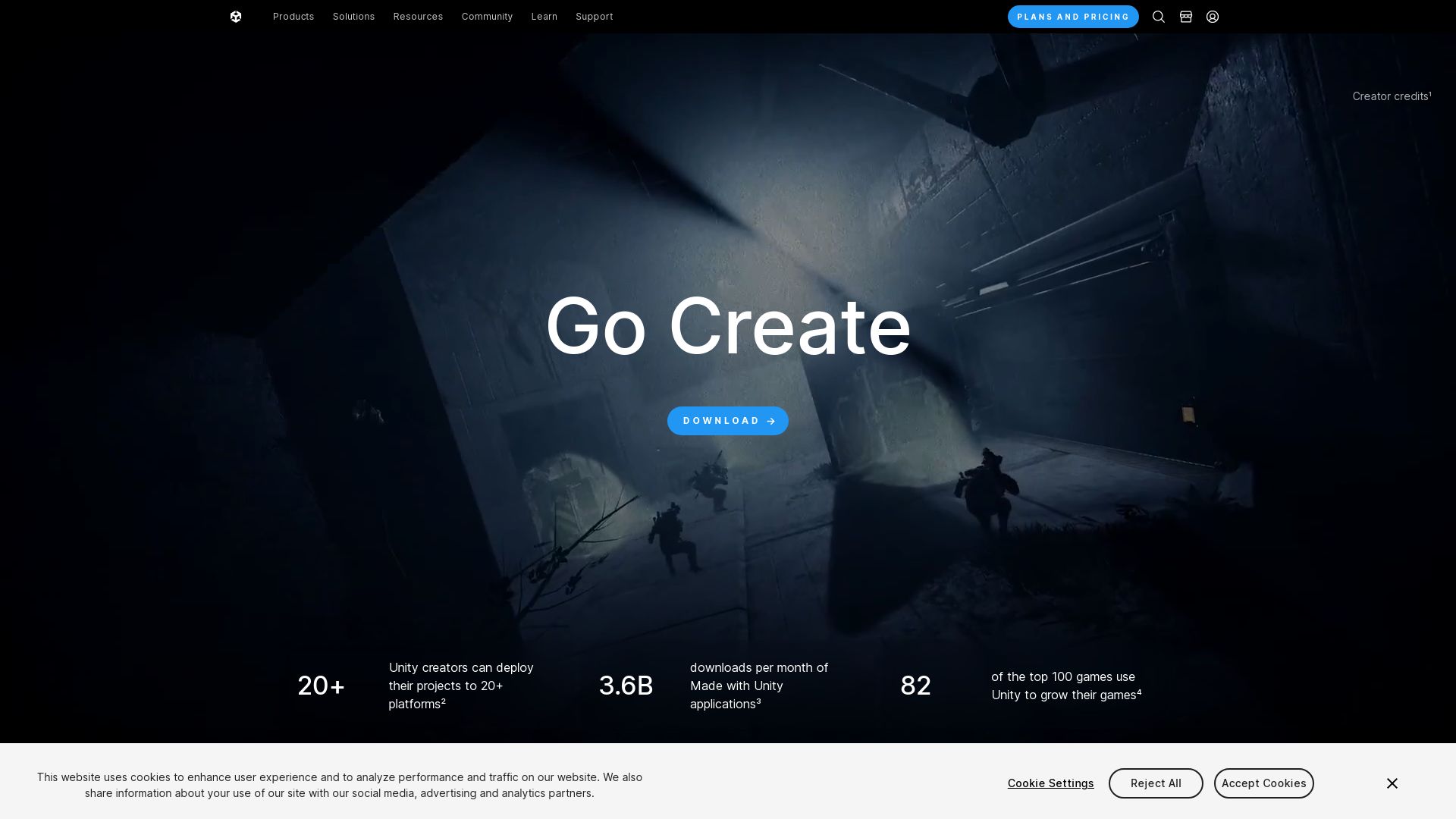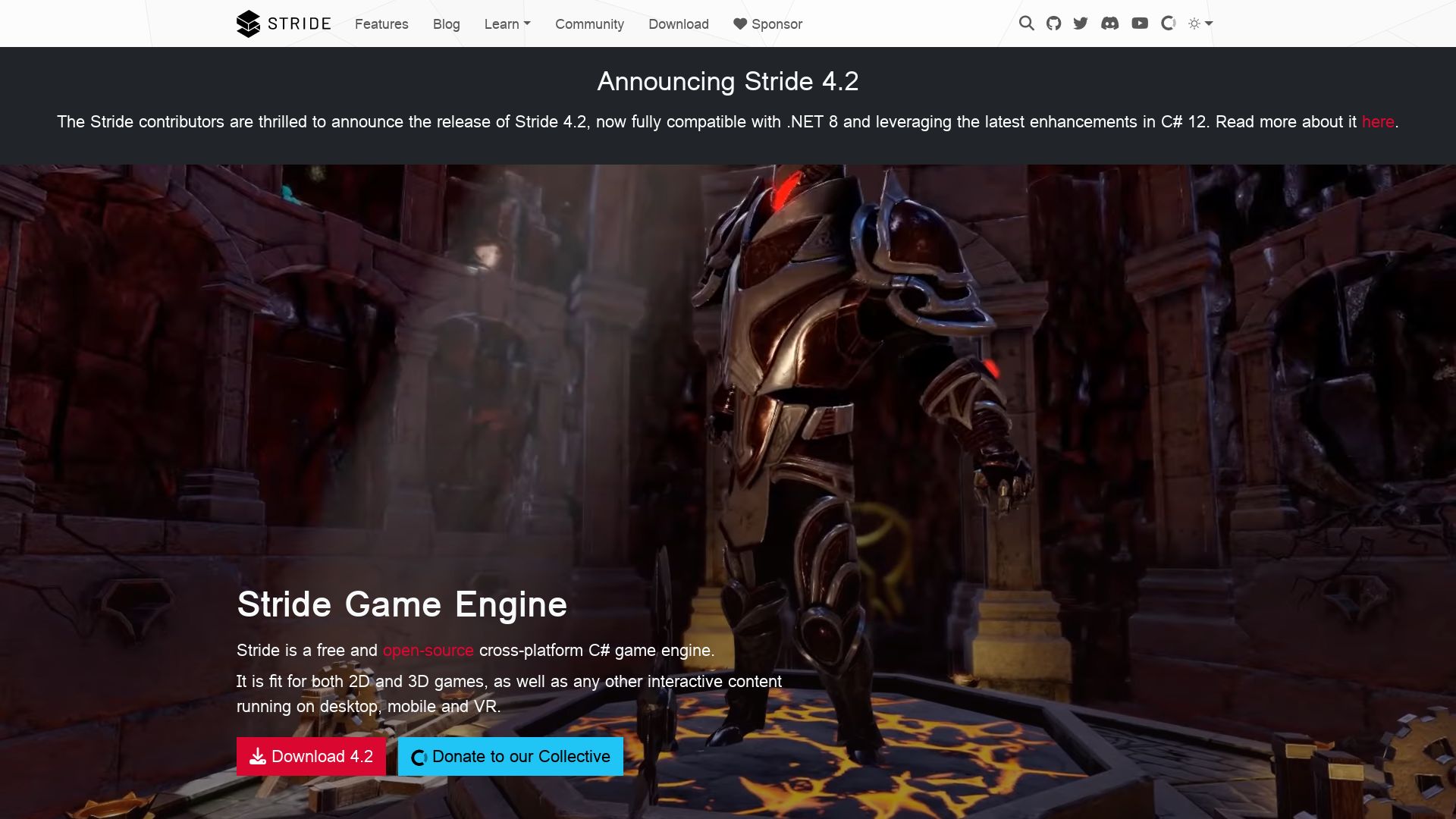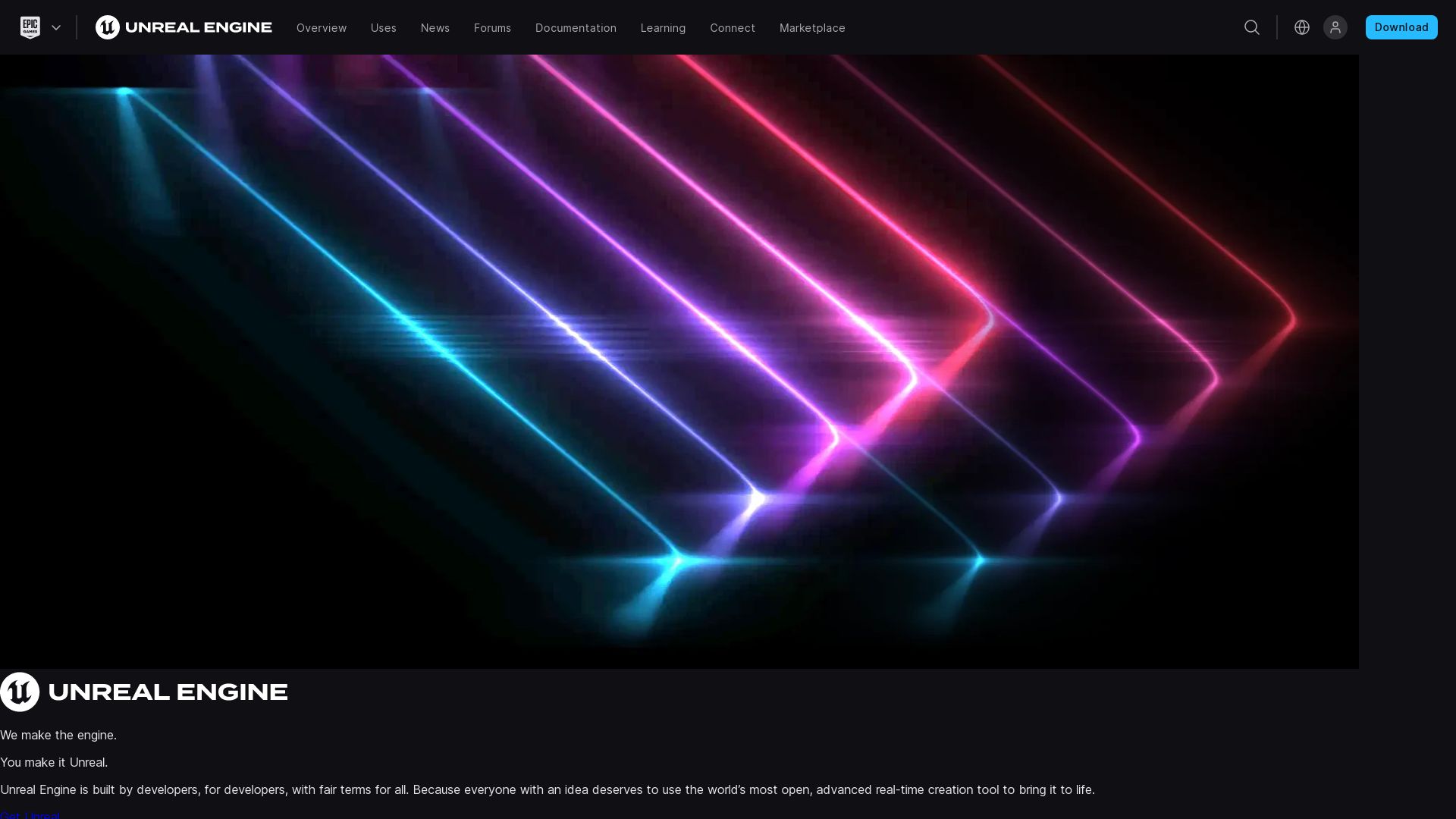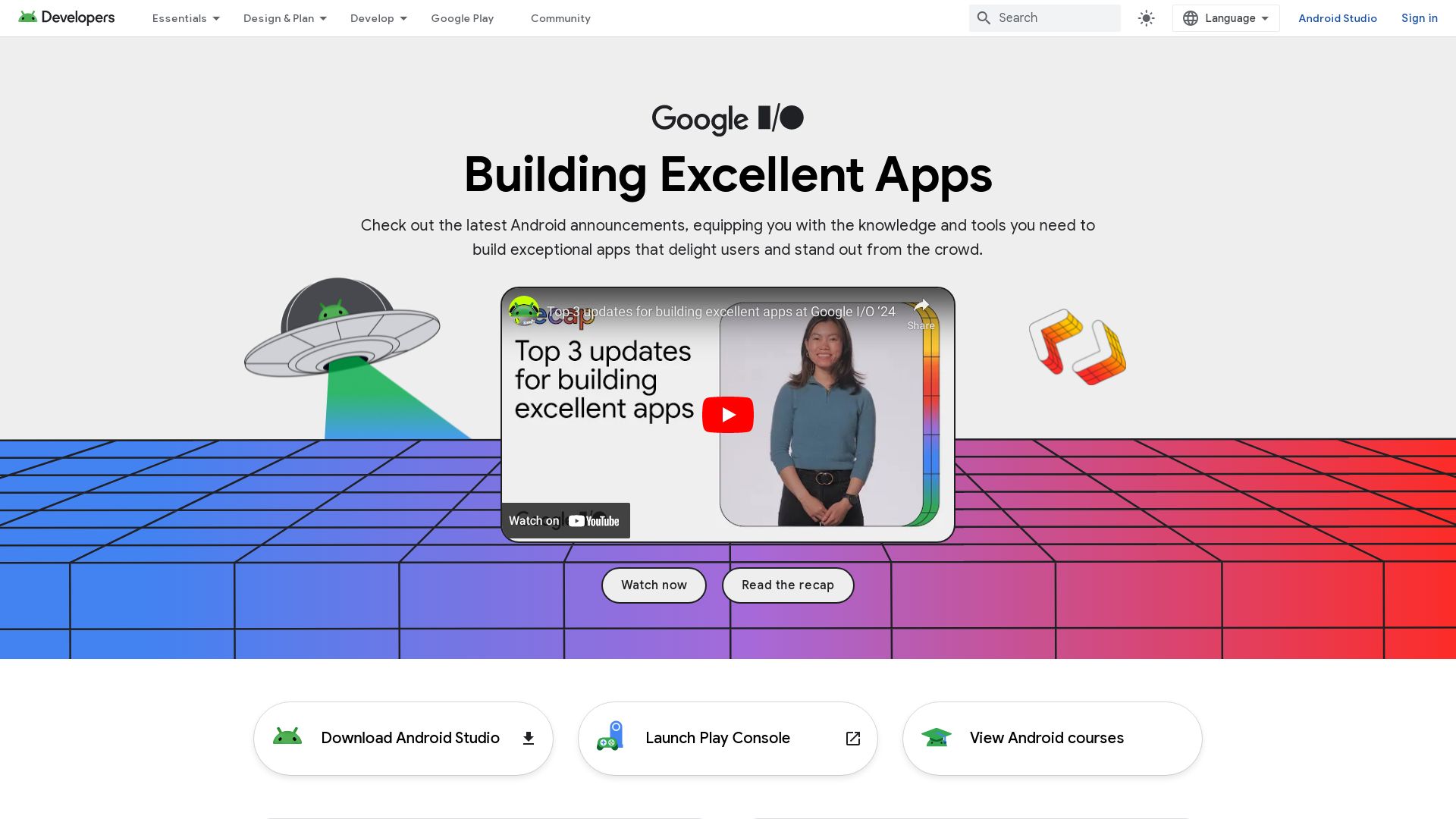Godot is a popular open-source game engine known for its intuitive scene-driven design and built-in scripting language GDscript. It supports multiple platforms and is free under the MIT license, making it ideal for both beginners and experienced game developers.

For those exploring alternatives to Godot, options include Unity, Unity3D, Unreal Engine, GameMaker, MonoGame, Construct 3, Construct, Babylon.js, Three.js, Android Studio, RPG Maker, Stride, and Defold.
Unity

Launched in 2005, Unity stands as a powerful game development engine recognized for its possibilities in creating immersive and multi-platform 3D and 2D games, as well as applications that include Augmented Reality experiences and 3D simulations.
Unity Top Features
- Cross-Platform: Unity allows developers to create games compatible with various platforms including Android and iOS.
- Tools and Tech: A suite of tools, advanced rendering technology, and innovative features support the creation of high-quality games.
- Rich Asset Store: Integrated store offering an array of pre-designed textures and features assisting game design brainstorming.
- Scripting Languages: Unity extends the choice for scripting languages like BOO script, Javascript, and C#.
- Active Community: Unity boasts an interactive developer community offering assistance, problem-solving, and constructive feedback.
Unity Downsides
- Pricing Controversies: The move to a new pricing model effective from January 1, 2024, has created concerns among developers, especially solo and indie creators, who fear high per-install fees.
- Mistrust: Sudden pricing shifts and lack of information about future changes have led to diminished trust between Unity and its users.
- Digital Preservation: Concerns exist over how the new Unity’s fees could impact efforts towards digital preservation.
Unity Pricing
Currently, Unity is embarking on a major pricing redesign. As per the new pricing structure, developers will be charged a fee every time a game using Unity software is installed after January 1, 2024. However, developers will not be asked for a fee until their game hits $200,000 in revenue or surpasses 200,000 installations. Games from “standard” markets, the US and UK for instance, will bear higher rates than those from “emerging” markets like India and China.
Unity Use Cases
Use case 1: Augmented Reality Experiences
Unity provides a gamut of features for the creation of captivating Augmented Reality experiences and virtual simulations, promoting interactive app development.
Use case 2: Mobile Game Development
This platform explicitly encourages the development of fascinating mobile games, taking into account the growing reach and popularity of mobile gaming.
Use case 3: Indie Game Development
Even solo developers and small studios can use Unity to produce intricate games packed with features despite the challenges related to pricing.
Unity3D

Developed by Unity Technologies, Unity3D is a widely used cross-platform game engine. Launched initially as a Mac OS X game engine in June 2005, it has grown in popularity due its ease of use for newcomers and indie developers alike and broadened its applications to non-gaming fields like film, architecture, or even the U.S. Armed Forces.
Unity3D Top Features
- Supports various platforms, including desktop, mobile, console, and virtual reality.
- Affords seamless integration with Visual Studio, C# scripting API, JavaScript scripting language and Mono Develop IDE.
- Offers an extensive cross-platform release functionality and an API for custom scripting tools.
- Large assortment of scripts, models, scenery, materials, and more on the Unity marketplace.
| Feature | Description |
| Creation | Supports the creation of both 2D and 3D games. The Box2D engine is used for 2D physics. |
| Performance | Developed in C++ and rigorously optimized for high performance. |
| Adoption | Adopted by various industries, extending beyond gaming. |
Unity3D Limitations
- Recent political changes and inconsistent pricing policies have resulted in a certain backlash within the community.
- Faces stiff competition from engines like Unreal, Godot etc.
- The business model is in flux due to revenue model alterations and user community reactions.
Unity3D Pricing
Unity3D adopts a varied approach to pricing. There are specific plans for students, personal use, and enterprises. Pricing depends on additional features, with different versions priced up to $1500. Companies with revenues falling below a threshold of $200,000 find the commercial terms of Unity most affordable. Notably, a ‘Per Install’ fee has been introduced from January 1, 2024.
Unity3D Use Cases
Use case 1: Mobile Game Development
Unity3D’s cross-platform support makes it particularly effective for iOS and Android mobile game development, enabling developers to reach a wide audience with their games.
Use case 2: Indie Game Development
With its user-friendly interface and extensive resources, Unity3D has become a favorite among indie developers. Its wide range of tools allows for creative freedom and experimentation in game development.
Use case 3: Industrial Applications
In addition to game development, Unity3D’s powerful engine and tools have seen application in industries beyond gaming like film, automotive, architecture, engineering, and construction.
RPG Maker
Created by ASCII, Enterbrain, Agetec, Degica, and Gotcha Gotcha Games, RPG Maker reigns in the world of game development with its origin dating back to 1992. This powerful software written in JavaScript and HTML5, primarily allows the creation of intriguing, story-driven RPGs and enjoys popularity in multiple languages including Japanese, Chinese, Korean, and English.
Top Features of RPG Maker
- Designed for development of RPGs with a story-centric lens
- Simple to use with no coding knowledge required
- Robust character creation options with over 200 DLCs
- Integration of different plugins, mainly free
- Extensive community support and modification sharing
| Feature | Benefit |
|---|---|
| Latest Version: RPG Maker MZ | Explores cross-platform functionalities |
| Background | First software in RPG Maker series unveiled in 1992 |
| Limitations | Opens doors for unique game designs with a strong narrative focus |
RPG Maker Limitations
- Constricted by the engine’s limitations
- Potentiality for failure without a proficient developer
- The game design scope can’t expand beyond certain boundaries
RPG Maker Pricing
While the software brags about the availability of over 200 DLCs, these added benefits will cost you between $5 to $25 per DLC.
RPG Maker Use Cases
Use case 1: Aspiring Developers
Its simplicity, as well as flexibility, stands as an attraction for beginner developers seeking practical experience in game creation.
Use case 2: Story-Driven RPGs
RPG Maker‘s focus on narrative-led elements enables developers to overcome technical limitations and stress on the creative facets of game development.
Use case 3: Community Support and Modification
The wide-ranging community of RPG Maker offers extensive modification sharing, enhancing the game development process.
Stride

Presenting Stride, a free, open-source game engine designed for 2D and 3D cross-platform development. Originated by Silicon Studio and formerly known as Xenko, it has evolved with a primary focus on PC, mobile devices, and virtual reality games.
Stride Top Features
- Comprehensive C# suite tools
- Customizable shader system
- Integrated environment in Game Studio for asset import, scene creation, script assignment, game building and running
- Photorealistic postprocess effects
- Full tool-chain includes particle editor, scene streaming system, sprite editor, scripting editor, UI engine
| Feature | Description |
|---|---|
| Cross-platform runtime support | Global compatibility with iOS, Android, Windows UWP, Linux, PlayStation 4 |
| Additional usage | Stride serves as a 3D rendering engine for vvvv gamma, a visual programming environment |
Stride Limitations
- For now, no support for Xbox as it stands today, despite mention in Microsoft’s Xbox Creators Program
- The shift to a community-supported model in 2018 means updates and fixes may be inconsistent or slower than with a dedicated company.
- The relatively complex nature may pose a steep learning curve for beginners
Stride Pricing
Stride runs on an MIT License, meaning it is completely free to use and modify, a definite advantage for developers on a budget or those wanting open-source freedom.
Stride Use Cases
Use case 1: Individual Developers
Stride provides an all-in-one development solution with its integrated asset importing and scene creation tools, making it ideal for individual developers seeking to streamline their workflow.
Use case 2: Professional Game development
With features like Physically-Based Rendering (PBR) layered material editor and photorealistic post-process effects, Stride caters to professional game developers aiming for high-level graphics and visual procedures.
Use case 3: Education
Stride serves as a comprehensive tool for teaching modern game development concepts, in both 2D and 3D, to students and educators in the field.
Defold

A popular choice among game developers, Defold is a free, open-source game engine, suitable for creating games on various platforms such as console, desktop, mobile, and web. It is known for its user-friendly license and no upfront costs, licensing fees, or royalties.
Defold Top Features
- Code and scene editors: Integrated code editor, along with a debugger, profiler, scene, and UI editors.
- Nature of the language: Game logic is written in Lua with an option to use native code for additional functionality.
- Cross-platform building: Offers cross-platform building capabilities, requiring no SDKs.
- Strong community: Active and friendly community on Discord and Forums.
| Feature | Details |
|---|---|
| Open-Source | Source code available on GitHub. Ability to fork and tailor to individual needs. |
| Development Languages | Primarily uses Lua, C/C++. Offers VSCode option and CLI build system. |
| Development Dimensions | Primarily designed for 2D games. 3D development is ongoing, expected to improve by end of 2020. |
Defold Limitations
- Requires a good understanding of Defold and Native-Extensions for flexible development capabilities.
- Scale of game development may be limited due to the small development team behind Defold.
Defold Pricing
Defold is completely free with no upfront costs, licensing fees, or royalties.
Defold Use Cases
Use Case 1: Commercial Game Development
Used by a growing number of developers for commercial hits, thanks to its rich technical documentation and ease of use.
Use Case 2: Game Jams and Schools
Defold is popular for use in Game Jams and schools, allowing rapid development and prototyping.
Use Case 3: Simulator and Apps Development
More than just games, Defold can be used to develop simulators and apps, with its highly compatible engine.
Unreal Engine

Unleashing the power of 3D computer graphics, Unreal Engine (UE) is a line of high-performance game engines developed by Epic Games. With its roots in PC first-person shooters, UE has significantly broadened its reach to encompass not only multiple game genres but also film and television industry applications.
Unreal Engine Top Features
- Comprehensive platform support, extending from desktop and mobile to console and virtual reality.
- Striking 3D graphics facilitated by the UnrealEd level editor with real-time constructive solid geometry operations.
- Incorporation of features from acquired companies like Quixel, augmenting the engine’s capability.
- A robust marketplace for creators to buy and sell their work, with a generous revenue share of 88% allotted to content creators.
- Free-to-use model for schools and universities, lowering the barrier to entry in game creation education.
| UE Edition | Key Stats |
| Unreal Engine 3 | Open for modification. Introduced free Unreal Development Kit (UDK). |
| Unreal Engine 4 | Released to all users for free in March 2015. |
| Unreal Engine 5 | Latest release as of April 2022. Boasts of superior graphics and speed. |
Unreal Engine Limitations
- 5% royalty payments for commercial projects earning over $1 million USD.
- C++ programming language requirement could be a hurdle for non-C++ developers.
Unreal Engine Pricing
Beyond the free access threshold, Unreal Engine operates on a royalty model, charging 5% of the revenue for products earning more than $3,000 per quarter. However, this model is waived for games published on the Epic Games Store.
Unreal Engine Use Cases
Use case 1: Game Development
From first-person shooters to console games, Unreal Engine’s advanced features and wide platform support make it a favoured choice for game developers worldwide.
Use case 2: Film and Television
Unreal Engine’s powerful 3D graphics capabilities are leveraged in film and television industries for creating realistic graphics and scenes.
Use case 3: Academia
In educational institutions, Unreal Engine serves as a teaching tool for budding game developers and animators, being freely accessible for schools and universities.
GameMaker
GameMaker, a prolific 2D game engine, furnishes an accessible platform for beginners and pro developers alike. Backed by years of dedicated refinement since its inception in 1999, GameMaker has enabled the creation of celebrated games such as Undertale and Chicory: A Colorful Tale, demonstrating its scalability and resourcefulness.
GameMaker Top Features
- Offers an intuitive game-making process with a emphasis on simplicity.
- Presents a robust toolkit that encourages scalability, ideal for projects of varying magnitudes.
- Lauded for maintaining a delicate balance between innovating new features, attending basic maintenance, and considering user feedback.
- Supports an array of languages with its Language Server for Syntax Highlighting and Intellisense support, inclusive of Shader Languages and JSON.
- Announced promising future developments, including a new code editor, AI support, and enhanced modding capabilities.
- Integration of Mod.io extension to facilitate the inclusion of user-generated content within games.
| Example Games | Reasons for Success |
|---|---|
| Undertale | Use of GameMaker’s expansive toolkit and simplicity. |
| Hyper Light Drifter | Embracing GameMaker’s scalability for a compact yet high-impact game. |
GameMaker Limitations
- Though it excels in 2D game design, it may not be as proficient for 3D game development.
- The scales of simplicity and power may lean more towards beginners, thus may limit the sophistication viable for advanced developers.
GameMaker Pricing
GameMaker presents a suite of pricing tiers to suit varying needs: Free for initial exposure, Creator for budding developers on desktop stores, Indie for broader release possibilities with multiple export options, and Enterprise for studio releases on major consoles.
GameMaker Use Cases
Use case 1: Beginner Game Developers
With GameMaker’s stress on simplicity and a toolkit that’s easy to grasp, it elucidates the entryway into game development, bolstering foundational understanding.
Use case 2: Indie Game Studios
GameMaker’s durability in supporting rising indie games emphasizes its power to develop unique, smaller-scale but impactful projects.
Use case 3: Education
GameMaker’s emphasis on easy use and learning resources, makes it an ideal teaching tool in academic settings for game design and development.
MonoGame

MonoGame is a powerful, open source, C# framework catering to game developers with a focus on cross-platform accessibility. Initially released in September 2009, MonoGame has grown to become a competent alternative engineering tool.
Top Features of MonoGame
- Cross-Platform Support: Capable of producing games for multiple platforms including but not limited to iOS, Android, macOS, PlayStation 4, and Nintendo Switch.
- Powerful API: Implements Microsoft XNA 4 API enabling deep control over the game development process.
- Community-driven Development: Maintained by independent software developers, MonoGame encourages contributions via the community site or GitHub.
- Robust Graphics Capabilities: Leverages OpenGL or DirectX for advanced rendering ensuring stunning visuals for games.
| Feature | Description |
|---|---|
| Content Management | Follows XNA 4 ContentManager model |
| Multi-dimensional Game Support | While first versions only supported 2D sprite-based games, 3D support has been included since mid-2013 |
| Game Schooling | Offers courses and tutorials for C# programming and MonoGame-specific tools. Ideal for 2D game development |
MonoGame Limitations
- Not designed for High-Level Programming: MonoGame focuses on the C# language and offers limited support for high-level programming.
- Availability of Paid Support: iOS and Android support options come at a cost.
- Community Reliance: While community contributions are key to its development, this can also result in slower updates and fragmented progress.
MonoGame Pricing
MonoGame stands out as a top choice for budget-conscious developers. With its open-source approach, it is completely free to use. However, one may need to pay for support on iOS and Android platforms.
MonoGame Use Cases
Use case 1: Cross-Platform Game Development
MonoGame’s cross-platform capability allows developers to create games for a wide range of platforms, including consoles, mobiles, and desktop, reducing the time and cost involved in separate development for different platforms.
Use case 2: Advanced Graphics
The framework’s support for OpenGL, OpenGL ES, or DirectX, coupled with its 3D capabilities, empower developers to craft visually captivating games.
Use Case 3: Learning Resource
For aspiring developers, MonoGame offers a fantastic learning opportunity. Provided courses and tutorials not only educate on C# programming but also offer a deep understanding of game development core concepts.
Construct 3

Developed by Scirra Ltd, Construct 3 is a robust HTML5-based 2D game engine catering to beginners and pros alike. It heavily stands out for its visual programming courtesy of ‘event sheets’. Ideal for 2D, small-to-medium sized games, Construct 3 is a boon for non-programmers too.
Construct 3 Top Features
- Visual Programming: Offers swift creation of games using ‘event sheets’. Implement actions when conditional triggers are met.
- Device Flexibility: Accessible on any browser-enabled device. Offline use supported too.
- Pixel Editor: In-built pixel editor facilitates easy game graphic creation.
- Behaviors Support: Robust behaviors support including solid, platformer, and tile movement among others.
- JavaScript Support: JavaScript as optional scripting language meets the needs of advanced users.
| HTML5 and Online Storefronts Support | Exporting Abilities |
|---|---|
| Superior to GameMaker with support for Google Chrome, Firefox, Internet Explorer 9+, Safari 6+, Opera 15+. | Exports game into a web app or uses an HTML wrapper. However, the ability is contingent on the device’s support for web content. |
Construct 3 Limitations
- Lacks native exporters.
- Limited offline application behavior.
- Not viable for large-sized or 3D game development.
Construct 3 Pricing
Scirra offers a free version and a paid subscription of Construct 3 starting at $99/year for the personal plan.
Construct 3 Use Cases
Educational Institutions
With its beginner-friendly interface and offline usability, Construct 3 is being used for coding curriculum in 400 schools across the US. Teachers can create advanced course curriculum simulating real-world game development scenarios.
Independent Developers
Among indie developers, Construct 3 is a favorite due to its easy programming process and quick game creation ability. Used for creating 2D video games, interactive advertisements, and embedded playable web apps.
Professional Game Developers
With its ability to swiftly create games using event sheets and integrated JavaScript for complex operations, Construct 3 is a reliable platform for professional game developers focusing on 2D game creation.
Construct

Let’s delve into Construct, an HTML5-based 2D game engine developed by Scirra Ltd. This engine has a user-friendly design catered to non-programmers, allowing for swift game creation via visual programming.
Construct Top Features
- Adds value for non-programmers with the use of visual programming and ‘event sheets’.
- Flexible support for both native and web-based applications with multiple platforms compatibility.
- Allows unlimited imagination and game development possibilities with ‘Free Programming’.
- Offers learning support with Hub features and checkpoints for understanding lessons
- Expands creativity through Construct Animate, the new animation tool based on Construct 3.
| Javascript Support | Including a JavaScript plugin SDK since 2012, Construct even added a dedicated JavaScript scripting language in 2019. |
| Operational Flexibility | Construct has consistently evolved its API technology and plugin SDK, moving from DirectX to NW.js and HTML5. |
| Multiple Platform Support | Construct ensures a multifaceted reach, supporting desktop browsers, mobile browsers, and gaming consoles. |
Construct Limitations
- The engine’s transition from a pay-once model to a subscription-based model may not be favored by all users.
- Over reliance on ‘event sheets’ could be a learning curve for traditional programmers.
- Limited to primarily 2D game development.
Construct Pricing
Previously sold on a pay-once model, Construct now operates on a subscription-based pricing model.
Construct Use Cases
Use Case 1: Game Development for Non-Programmers
With visual programming and ‘event sheets’, Construct simplifies the game development process for non-programmers, empowering them to transform their game ideas into reality.
Use Case 2: Teaching Programming Concepts
Teachers and trainers can leverage Construct to teach programming concepts without requiring a deep understanding of coding languages.
Use Case 3: Cross-Platform Game Development
Construct’s wide compatibility range makes it ideal for developers intent on creating games for multiple platforms, be it desktop, mobile devices, or gaming consoles.
Babylon.js
Emerging from the cyberspace womb of 2013, Babylon.js, a brainchild of David Catuhe, has fast evolved into a robust real-time 3D engine. This remarkable tool, primarily nurtured by Microsoft’s diligent workforce and a vibrant community of contributors, displays 3D graphics directly in your web browser using HTML5.
Babylon.js Top Features
- Interoperability: Babylon.js’ code, written in TypeScript, is available in JavaScript too, paving a pathway for broader accessibility.
- Rendering Prowess: The engine employs physically based rendering and post-processing methods to produce photo-realistic images.
- Plugin Physics Engines: Integrations with Cannon.js and Oimo simulate collisions and real-world physics, setting the stage for immersive gaming experience.
- Animation Capabilities: Advanced character animation with skeletons and blend weights enable dynamic movement designs.
| Original Author | Current Version |
|---|---|
| David Catuhe | Stable Release 5.3.0 |
| Repository | License |
| github.com/BabylonJS/Babylon.js | Apache License 2.0 |
Babylon.js Limitations
- Limited Solid Geometry: Babylon.js has restricted usage of constructive solid geometry for union, subtraction, and intersection of shell models.
- Dependency on HTML5: Both the 3D engine and the user code rely heavily on HTML5 and WebGL supportive browsers.
Babylon.js Pricing
Revolutionizing the realm of 3D visualization comes at zero cost with Babylon.js. An open source wonder, its source code is freely available under the Apache License 2.0.
Babylon.js Use Cases
Use case 1: Virtual Worlds Creation
The brilliant blend of advanced rendering, physics engines, and animations provide a perfect platform for creating immersive, lifelike virtual worlds.
Use case 2: Data Visualization
Babylon.js creates a unique data representation platform, enabling compelling visualization of complex data, such as crime statistics or RDF graphs.
Use case 3: Education
The powerful 3D engine brings learning to life, transforming education fields such as medicine and historic sites modelling, by providing interactive, detailed virtual models.
Three.js
Three.js is an open-source JavaScript library and API developed by Ricardo Cabello that primarily focuses on creating, displaying, and animating 3D computer graphics in a web browser environment. It leverages the power of WebGL for GPU-accelerated 3D animations and boasts cross-browser compatibility.
Three.js Top Features
- High-level libraries: Three.js simplifies detailed and complex 3D animations creation with its feature-rich libraries.
- Enriched support options: Offers wide-ranging support for objects, geometry, lights, materials, shaders, scenes, animations, and effects.
- WebGL 2.0 usage: As of version 118, Three.js has integrated WebGL 2.0, with WebGL 1.0 being available via WebGL1Renderer class.
- VR & AR Support: Integrates WebXR for seamless Virtual and Augmented Reality experiences.
| Features | Contributors |
|---|---|
| GPU-accelerated 3D animations | Over 1700 contributors on Github |
| Cross-browser compatibility | Runs in all browsers that support WebGL 1.0+ |
Three.js Limitations
- Requires understanding of 3D modeling and animation
- Lack of a dedicated tech support team due to its open-source nature
Three.js Pricing
Three.js is an open-source project and free to use, courtesy of its MIT License.
Three.js Use Cases
Use case 1
If you’re into creating intricate 3D animations for a web browser environment, Three.js has the tools and libraries to simplify that task.
Use case 2
For developers working on Virtual or Augmented Reality applications, Three.js’ integrated WebXR support comes in handy.
Use case 3
Open-source enthusiasts or contributors will find working with Three.js a significant learning experience due to its extensive Github community.
Android Studio

As the official IDE for Android app development, Android Studio has cemented its position in the industry. Equipped with IntelliJ IDEA code editor and developer tools, this flexible Gradle-based build system flaunts a feature-rich emulator and covers development for all Android devices.
Android Studio Top Features
- Live edit for real-time updating of emulators and physical devices
- Integration with GitHub and provision of code templates for enhanced feature building
- Extensive testing tools and frameworks, including lint tools for analysis of performance, usability, and version compatibility issues
- Support for languages like C++, Java, Kotlin and more through extensions; and built-in support for Google Cloud Platform
- Customizable build process with options to extend and configure as per needs
- Creation of multiple APKs for an app using the same project and modules, facilitating resource and code reuse
| Feature | Description |
|---|---|
| Smart Editing | Advanced code refactoring, deep static code analysis to improve development quality |
| GUI | Develop apps for various resolutions and locales with ease |
| Debugging | Offers in-line debugging for code walkthrough, performance analysis and memory usage profiling |
Android Studio Limitations
- Packed with multiple advanced features, it might seem overwhelming for beginners.
- Requires a high system configuration of 8 GB RAM, 8 GB Disk space, and 1280 x 800 screen resolution.
Android Studio Pricing
Rejoice, developers! Android Studio is free for use.
Android Studio Use Cases
Use case 1
For Android app developers, Android Studio proves vital with its integrated tools, extensions support, and resource reuse capability
Use case 2
For businesses, Android Studio’s multiple APK creation per project enables provision of featured variants of the same app.
Use case 3
For beginner programmers seeking hands-on with real-time debugging, Android Studio’s in-line debugging tool provides invaluable learning experience.
Hannah Stewart
Content writer @ Aircada, tech enthusiast, metaverse explorer, and coffee addict. Weaving stories in digital realms.





